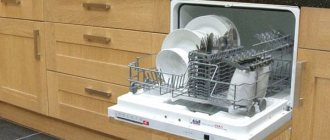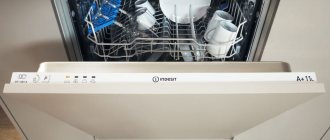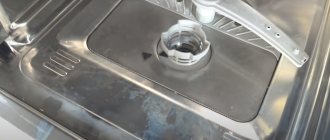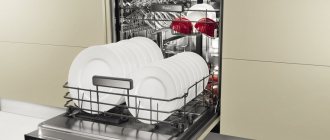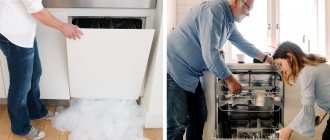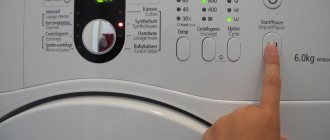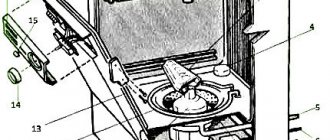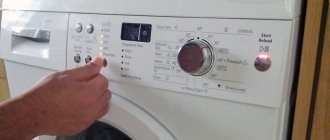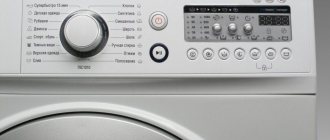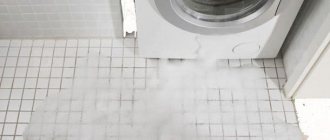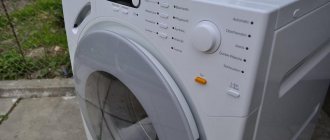Resetting the program in Bosch dishwashers
Sooner and later, any equipment fails, but the reasons can be completely different. Bosch dishwashers are no exception. Despite the high build quality and innovative technologies, German technology also sometimes refuses to work fully, but thanks to the built-in diagnostic system, the user can promptly identify and solve the problem. As a rule, any minor repairs and reprogramming of a household appliance are accompanied by resetting all settings, and the further functionality of the dishwasher depends on how correctly it is performed.
What to do if error E15 appears in a Bosch dishwasher
When an error with number E15 appears, the only way out of this situation is to eliminate it, but you should not immediately rush to disassemble the car. First, they try the standard procedure based on resetting the settings. If this does not help, the fault of the Bosch dishwasher is looked for in the elements of the drainage system.
Reset
If the machine is new, the appearance of error code E15 is not necessarily associated with a breakdown of the drainage system unit. It may simply malfunction due to strong foaming of the detergent, a power surge, or for another reason. To restore the operation of the Bosch dishwasher, you first need to try resetting the settings.
When resetting the settings, the power cord of the machine is pulled out of the socket.
The easiest way to eliminate error number E15 is to unplug the machine's power cord from the outlet. When turned off, it lasts up to 20 minutes. When, after turning it on again, the error code E15 is displayed again, it is possible that this Bosch model resets the settings using a different algorithm.
For some dishwashers, the manufacturer has provided for clearing the ECU memory. To do this you need:
- open the loading door of the machine;
- press and hold program buttons 1 and 3 for 4 seconds;
- the loading door of the machine is closed and then opened again;
- the machine has a Reset key, which you press and hold for 4 seconds;
- Close the dishwasher door again and wait for the signal to end the program.
The loading door is opened and the power plug of the machine is removed from the socket. When you turn it on again, the error code E15 should disappear and the dishwasher will resume operation.
There is a third option to solve the problem for other models. To eliminate error E15 in a Bosch dishwasher, you can reset the settings by holding down the power button for 30 seconds.
Restoring the functionality of a stuck float
When the Aquastop float stops working, an error code E15 appears. The problem is often related to sticking. The float is glued by residual fats and sticky substances from detergents. Repairing a dishwasher can be done without disassembling it.
The float of the Bosch machine is lightweight, made of plastic and foam
The machine is disconnected from the network, water supply and sewerage. If the device is a built-in type, it will have to be removed from the niche. The dishwasher is rocked in different directions, tilted at an angle of up to 30°. Rags and trays are made into devices for collecting water. The car is tilted at an angle of 45°, and all the dirty liquid is drained from the pan. The return connection to the water supply and sewerage is carried out within 24 hours. During this time, the stuck float should restore its operation, and error number E15 will disappear.
Cleaning the filter and other drainage elements from blockages
The drainage system is equipped with a filter that retains food residues washed off from the dishes. It needs to be cleaned periodically. If the user forgets about this, the Bosch dishwasher displays error E15 and the faucet on the display lights up.
The filter is installed on the bottom of the working chamber next to the rocker arm
The basket for loading dishes is removed from the machine chamber. It's easy to see the filter on the bottom. On new Bosch models, it is removed by turning the housing 90 degrees. In older dishwashers, the filter removal process may vary. All you need to do is rinse the mesh well with detergent. After cleaning, the filter is returned to its place.
The mesh is not capable of retaining liquid fat. It penetrates the drain system, deposits on the walls of the hose, narrowing the passage openings. To clean the entire system, perform the following steps:
- The machine is disconnected from the network and communications, pulled out into free space. It is necessary to organize access from all four sides.
- First, remove the basket and filter from the working chamber. Unscrew the hardware on the side walls of the dishwasher body and remove them.
- Use a star-shaped screwdriver to unscrew the hardware and remove the front panel. There is a steel strip underneath it. It also needs to be removed by first unscrewing the screws.
- The next step is to remove the back wall from the case by unscrewing the fixing screws. A pump will appear before your eyes. It is secured on the pallet with rubber bands, which also need to be removed.
- Remove the plastic plugs from the sides of the machine. The door, which is held in place by a special holder, is disconnected from the body. You need to immediately find the cord and free it from the spring. After these steps, they try to remove the lower wall of the machine body.
After dismantling all the walls, all internal components of the dishwasher will open.
The drainage system hoses are clamped with clamps
All rubber tubes of the drain system are put on the pipes of the working units and clamped with clamps. They need to be weakened. The hoses are removed, inspected for integrity, and washed with water and detergent. Severe blockages are cleaned with a brush on a long handle. Upon completion of cleaning, all parts are reassembled in reverse order. The machine is connected to communications and the network, the functionality is checked, and the error E15 is not shown on the display.
Failure of Aquastop and sprayer rocker arms
In practice, a situation arises when, with error E15, the Bosch dishwasher does not turn off or cannot be turned on. At the same time, the filter and drainage system are clean, the pan is free of water. The problem is hidden in the Aquastop sensor or the sprayer rocker arms. Sometimes these parts fail.
There are two spray arms inside the tank: one on top and the other on bottom.
Failed parts cannot be repaired. The sensor and rocker arms are changed. First, the old components are dismantled in order to accurately select the appropriate model in the store.
When is a reset necessary?
Malfunctions of the dishwasher can lead to it not washing or rinsing dishes properly, increasing resource consumption, and changing the cycle time.
In addition, this can lead to complete breakdown of the unit, when professional repairs and replacement of expensive parts cannot be avoided.
You can prevent this outcome by resetting your household appliance yourself, which is done in two ways.
Completely disconnect the dishwasher from power supply for 20 minutes. This time is sufficient to restart the electronic module of the device.
Press and hold the “Start/Power” button for 10-20 seconds. This is also enough to reset and reboot the device.
However, such an algorithm of actions is appropriate if the cause is clearly defined and the error is deciphered, which is displayed on the machine display. Otherwise, you will need to reset the settings to factory settings.
As practice shows, the list of the most common reasons for failure to fully operate the device includes:
electronics module failure;
stopping and crashing the current program;
clogged filters and hoses;
incorrect position of the water supply and drain hose;
lack of water supply in the system;
All of the above problems can be easily fixed by restarting, however, there are problems that require more serious manipulations. These include:
pump failure;
automatic activation of protective programs, for example, AquaStop, which signals possible leaks in the dishwasher.
If resetting the settings and restarting the unit does not restore the full functionality of the dishwasher, then professional diagnostics and specialist assistance will be required.
How to reset?
To correctly reset the settings to factory settings and get rid of all the accumulated errors on the dishwasher display, it is enough to carry out a series of manipulations, strictly adhering to the order. So, the program reset algorithm in Bosch dishwashers includes:
opening the car door;
pressing the start key;
simultaneous activation and holding of the buttons responsible for launching programs 1 and 3;
closing and reopening the door;
pressing and holding the Reset button for 5 seconds;
closing the door and waiting for the washing cycle to complete – the end is indicated by a glowing indicator;
opening the door and completely disconnecting the device from the power supply.
All of the above manipulations will allow the dishwasher to reboot and delete all error codes from memory, that is, return to the factory settings.
Recommendations
Compliance with basic preventive measures can prevent malfunctions and malfunctions in the dishwasher.
Regular temperature control of the water that enters the machine. For Bosch dishwashers, this figure is within 50-60 degrees.
Continuous cleaning of filters and rocker arms that spray water, as well as sewer and water hoses.
Control of all detergents that must be added in the quantities provided by the device. In addition, do not neglect the use of additional care products for the device.
Use the unit strictly according to the attached instructions. This also includes loading dishes correctly.
Selecting suitable detergents that match the programs and options of the machine. An incorrectly chosen product can negatively affect the quality of washing and can also lead to damage to the dishwasher. You should be especially careful when choosing 3-in-1 or 5-in-1 tablets, since not every dishwasher is designed to use this type of detergent.
Correct electrical connection. The safest way is to connect through a voltage stabilizer, which will protect against surges and other failures in the electrical network, which are often the cause of breakdowns of household appliances.
In addition, do not forget that after each use of the machine it is necessary to ventilate it, leaving the door open for 20-30 minutes. This will prevent the appearance of unpleasant odors inside the bunker, and will also protect against the formation of microbes and corrosive processes.
Source
Dishwasher interior
At first glance, the operation of a dishwasher seems simple: install the unit, connect it, put detergents in the right places, arrange the utensils, select a program, start the equipment. Then you can forget about the dishes for a while and do something more enjoyable.
But I wonder what is happening inside the dishwasher at this time? After starting the machine, water flows into a special tray through an open valve. Enriched with detergents and regenerating salt, it heats up to the temperature you set.
The process itself is identical to washing dishes by hand. The structure and operating principle of dishwashing equipment are described in detail here. We recommend that you read this very useful information.
It depends on the program you have installed and consists of three to four stages:
- soaking if the dishes are very dirty;
- washing;
- rinsing;
- drying.
The duration of these periods is influenced by the initially set water heating temperature. The higher the threshold you set, the longer you will have to wait for the cycle to end.
When soaking, which is sometimes called a pre-wash, the main dirt is washed off from the dishes with cold water without the use of chemicals from the main container. This function is convenient if dishes are loaded into the machine in stages as they accumulate. It will prevent dirt from sticking tightly to previously loaded kitchen items.
The washing itself involves treating the dishes with hot water at about 80ºC. You can simply increase the washing time, but the advantage of the first option is that no detergent components are used.
Water along with the chemical composition is sprayed using special tubes located at the top or bottom of the body. The rocker washes dishes more efficiently. During rotation, it sprays water jets in all directions under powerful pressure.
At the end of the washing stage, the PMM automatically turns on the next one - rinsing and drying.
Rinsing in a dishwasher, similar to a washing machine, involves two stages. This is the only way to completely remove detergents from all surfaces of washed dishes.
Standard operating modes
Dishwasher programs are a sequence of operations that the microprocessor performs.
The main parameters are:
- Presence or absence of pre-soaking mode.
- Water heating temperature.
- Duration of the program.
After repeated use of the PMM, it will be easy to recognize how it functions and detect malfunctions by ear.
Types of drying in PMM
Drying completes the washing cycle. It comes in three types: blowing with heated air (turbo-drying), an intensive process with a heat exchanger, and condensation.
The first method involves blowing warm jets of air over the treated dishes. The implementation of the process is possible thanks to the presence of a fan built into the design. Drying occurs faster, but energy consumption is increased.
Enhanced drying is carried out due to the independent movement of air inside the housing as a result of the pressure difference. This method gives good results with more economical consumption of electricity.
During condensation drying, drops of water evaporating from the surface of the dishes are transformed into condensation and settle on the walls, then flow down. This drying method takes a lot of time, but if there is nowhere to rush, then this method is the best.
Standard cycle time
Modes for different PMM models may differ. Still, there are four basic washing modes in a dishwasher, which each manufacturer includes in its program. These modes are called fast, normal, economical, intensive. Let's consider each of them as guidelines for choosing a dishwasher.
When choosing a quick wash, the pre-wash and dry function is no longer required. The process lasts about half an hour. In the instructions for some models, this type of dishwashing is called rinsing. This mode is used when a small amount of not very dirty dishes has accumulated.
In normal mode, which includes a fully completed cycle, the dishwasher runs for an average of two hours, of which:
- Rinse - from 5 to 10 minutes.
- Main wash – up to 50 minutes. at a water temperature of 65⁰.
- Rinse in three steps - up to 10 minutes.
- Drying - the rest of the time.
Economy mode significantly reduces time by increasing temperature and pressure. This results in less water being wasted, but energy consumption increases. The program contains a preliminary rinse, a wash at 50⁰, a double rinse, and drying.
Read also: Device for dressing a grinding wheel
Very dirty dishes are washed using an intensive mode for 2-3 hours. This program includes pre-rinsing, washing at 70⁰, rinsing in four steps, drying.
It is better to wash pans and pots in the “pre-soak” mode. Particularly greasy kitchen utensils should be kept in the sink under very hot running water before loading. This will help the dishwasher do a better job.
Some models are also equipped with the following programs:
- EatLoad-Run , which allows you to load dishes directly from the dining table. There is a quick wash at 65⁰, then rinsing and drying, and all this in 30 minutes.
- Wash delicate at 45⁰ . Used for crystal, porcelain, glass. Duration: 110 minutes.
- Car wash (Auto) - this program, without outside intervention, determines the degree of contamination and automatically sets the required amount of water, detergent and the duration of the process. The usual water temperature in this mode is from 45 to 65⁰, duration is 2 hours 40 minutes.
The latest PMM models have the Varlo Speed , which allows you to reduce time by up to 50%. Not everything is so simple here - while saving time, electricity consumption increases. When choosing a mode, you need to calculate what is more profitable for you - saving time or energy.
Floor-standing models that hold a minimum of eight sets have a half-load mode . This means that only one of the available two baskets is loaded. At the same time, the washing time is not reduced, but the volume of water, detergents, and electricity used decreases.
The variable washing program provides for simultaneous processes - washing dishes in intensive mode and soaking. These two jobs happen in different baskets. Using the program allows you to save about 25% of water while maintaining excellent washing quality.
“Delay Start” function is very relevant . With its help, you can move the start by 1 – 24 hours. If you have a double tariff for electricity, this is very convenient.
Additional functions of PMM
In parallel with dishwasher modes, they can also have additional functions. Almost all of them are equipped with leakage protection. If there are small children in the house, you need a unit with the ability to lock the control panel or door.
The ability to add forgotten dishes after starting the machine is also a very convenient feature. Elite models are equipped with loading sensors. In this mode, the PMM selects both the volume of water and the time spent on the cycle.
Some models have additional elements - sensors for monitoring water purity and hardness. A sensor for monitoring the degree of water purity forces the unit to rinse everything loaded into the machine until the liquid becomes perfectly clean. If the water is very hard, the machine will determine how much softening salt to add.
Built-in units in working condition project a red beam onto the floor plane. When the process is completed, it disappears or its color changes to green. This is very convenient, because... makes it possible to monitor the operation of the built-in dishwasher.
Control of washing modes
All modes in the PMM are coordinated in two ways: electromechanical and electronic. The second method is more comfortable, and all modern models are equipped with it. The first provides for the presence of buttons, switches and keys on the body, and they are controlled manually.
With electronic control, both the washing mode and other programs are set using commands. If the PMM board fails, only a specialist can repair it. Experience shows that most often the programmer will have to be changed.
The final stage of machine operation
At the end of the cycle, the contaminated liquid goes down the drain. This is followed by a drying stage. It can end in 30 minutes or last more than an hour.
A special signal sent by the device will notify you of the end of the program. The sound volume is adjusted using convenient indicators placed by the manufacturer on the control panel. With their help, you can completely disable the alert function if you plan to load the machine overnight.
When the unit stops completely, press the on/off button. Then the door is opened slightly to allow the dishes to cool faster.
After drying, a high temperature remains inside the unit, so it is not recommended to immediately empty it of its contents. In addition, cookware made from certain materials becomes very fragile when hot.
It happens that the cycle is completed, but the dishwasher does not turn off. The most likely cause is an electronic problem. This may also be a consequence of blockage of the drain hole with food debris. The machine cannot shut down correctly.
Program duration for some models
Let's see how the duration of the modes differs for individual PMM models. For this purpose, we will analyze several popular examples of dishwashers of different brands and the duration of washing with these machines.
Based on reviews from many users, we can conclude that the most frequently used modes are fast and intensive.
The main advantages of the Bosch brand
When choosing a dishwasher, many buyers focus on the brand and build quality. Bosch units rightfully occupy first place among all models. This company from Germany receives a lot of positive reviews about its equipment. There are several advantages of the brand:
The cost of Bosch technical devices is quite reasonable and, combined with quality, is attractive to many consumers.
It is these advantages that make Bosch dishwashers the most popular among buyers.
Basic error codes and ways to solve them
You need to remember that, despite the high-quality assembly and reliability, a dishwasher is a technical device, so the possibility of breakdowns cannot be ruled out. Depending on the type of error, you may be able to resolve it yourself or you will have to contact a service center specialist. There are several groups of faults that appear with certain signs on the display.
Heat
A problem with water heating in your dishwasher shows several signs. Each of them has certain features.
E2 (F2)
The E2 (sometimes F2) icon appears on the display when the internal water temperature sensor is not working properly. In this case, the heater works well, but information about the increase in water degrees does not reach the control unit. If such an error is not corrected, then after some time the heating element may burn out.
E09 (F09)
Error E09 occurs when the flow heater is not working well. More often it appears in dishwashers, where the heating element is installed in the depths of the circular pump. To identify the problem, it is recommended to conduct a thorough inspection of the unit. If the multimeter shows zero resistance, then the heater will need to be replaced.
E11 (F11)
Indicator E11 indicates nutritional problems. Occurs when there is a breakdown in communication between the control module and the temperature sensor. Various reasons can provoke this phenomenon. It is necessary to diagnose the contacts, wiring of the temperature sensor and the control module. Before carrying out repairs, the machine is disconnected from the electrical network.
How to reset errors
Errors in the operation of a Bosch dishwasher often cause panic among consumers. However, there are several ways to eliminate them.
First way
The first method involves disconnecting the unit from the electrical network. It is recommended to leave the device in this state for 20 minutes and then try to turn it on. As a rule, after such an action, the control module restores operation and the errors disappear.
Second way
The second method of resetting errors is simpler - you need to press and hold the “Power” button for 15 seconds. This action resets the settings to factory level. As a result, the functionality of the dishwasher is restored.
Two ways to reset dishwasher errors
If you have figured out the cause of the breakdown and decided on further actions, you can reset the error code.
There are two easy ways to do this:
- Disconnect the dishwasher from the power supply for 15-20 minutes. This time is enough for the control module to reset its settings and restart.
- Press and hold the “Power on” network button for 10-15 seconds. After this action, the equipment settings are also reset.
The recommendations described are suitable for dishwashers of different brands and models.
Errors in Bosch and Siemens dishwashers
Sometimes situations arise when the question arises of how to reset the program on a Bosch dishwasher or another model. Cancellation is simple - just press the Start button and hold it for 3 seconds. The indicator lights should go out. After turning off the dishwasher, it will begin draining water. This happens within about 1 minute. But it happens that there is a problem with the dishwasher. Error codes start flashing on the display. In this case, you also need to know how to reset the settings.
Installing a Bosch dishwasher
While a compact dishwasher can easily find a place on the countertop, placing a larger built-in model requires some thought. The machine is installed taking into account the location of communications, namely: to the left or to the right of the sink. Some miniature devices fit directly under the sink.
When integrating the machine into an existing kitchen unit, it is necessary to dismantle the selected cabinet to free up space:
- remove the door from its hinges;
- remove all shelves;
- remove the back wall and bottom panel.
If you can’t get rid of the back bar, you will have to make holes in it or the side walls necessary for the hoses to come out. Some modern manufacturers provide a niche for a dishwasher when making furniture. To protect the tabletop from moisture, a sheet of metal is attached to its inside.
To ensure proper operation, the device must be connected in accordance with the supplied instructions. To do this you should:
- carry out installation of all parts provided in the package;
- adjust the position of the machine using a building level;
- connect the equipment to the drain;
- provide cold water supply;
- connect the machine to the electrical network.
To install the dishwasher you will need the following tools and accessories:
- adjustable wrench;
- pliers;
- screwdrivers;
- roulette;
- building level.
I work in the household appliance repair industry. Extensive experience in restoring washing machines and dishwashers.
Typical faults
If the machine gives an error, then there is probably one of the following typical situations:
The washing program is stuck
While the dishwasher is operating, various errors may appear. Experts say the most common problem is that the washing program freezes. Which is why you need to switch the program, that is, reboot it. Many errors have codes, the decoding of which can be easily found in the instruction manual. Brief data is displayed directly on the display.
The control module program describes system failures. This allows the machine to perform self-diagnosis and alert you to various problems. Often the error does not disappear even if the device is turned off/on or rebooted. In this case, there is no choice but to determine the cause and eliminate it completely.
Program freezing is caused by a number of reasons. But often this happens because the user does not perform periodic cleansing and prevention . As a result, the filters become clogged, the sensors are triggered and the control module blocks the functioning of the device components. Once the blockage is cleared, everything returns to normal.
Sometimes during work several errors of different types accumulate. They do not interfere with washing and are not considered serious. But after some time, the dishwasher may malfunction or not start and stop switching programs. And this is dangerous because more serious breakdowns will appear in the future.
There is an overflow of water
If the PMM overflows water, this may indicate:
Sensor operation
Before you figure out how to cancel the program in the Bosch Silence Plus, SMV D RU, SMV EX R, SP, Supersilence dishwasher, as well as Electrolux ESL LO, Siemens, you need to study the operation of the sensors. Sometimes there is a malfunction in their work.
Let's look at the error codes using the Bosch Super Silence machine as an example:
The dishwasher is electrocuted
This is a rare problem, which indicates that the electric heating element is not broken, but there is a hole. It occurs due to long use, manufacturing defects or very hard water. Diagnostics and repairs are performed at the service center.
Water saving level in dishwashers
Both the selected washing mode and the PMM model determine how much water it will consume. On average, this is from 10 to 13 liters per procedure as a whole. Unlike manual washing, all water is used only for its intended purpose without any loss.
During the process, the working fluid is cleaned using special filters and is supplied completely renewed for rinsing. Economy modes reduce the amount of water consumed by 25%.
Read also: Homemade face protection from an angle grinder
The profitability of PMM is indicated by symbols. Highly economical units are marked with the letters A, B, C. They consume 9 - 16 liters. Average-economical dishwashers are designated in the form of the letters D, E. They consume slightly more water - up to 20 liters. Low-efficiency machines with the letters F, G require 26 liters per cycle.
Emergency actions if an error occurs in the dishwasher
All methods of handling the dishwasher are described in detail in the instructions. There is not always time to choose and think for a long time about what actions to take. In such situations it is necessary to interrupt the program. To do this, turn off the device for 20 minutes or press the Start button for 15 seconds. After this, they begin to understand the cause of the problem.
If the breakdown is simple, for example, the water drain hole is clogged and the PMM has not completed the program, then you can fix it yourself. In the first case, the drain is cleaned, in the second, the program is restarted. But there are situations when the reason is completely unclear. This requires the help of a master.
